Marshall, Wisconsin
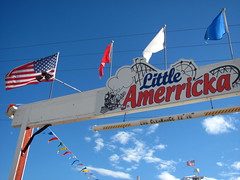 Are we sure the park is nearby? Although we have faith in the GPS device, it’s a little incredulous to believe that in the middle of this remote rural countryside we can be less than two minutes away from an amusement park that’s home to four separate roller coasters. Just as we began to think that it had surely made an error in calculating the correct distance, a small town crops up among the, well, the crops. I think Clark Kent once lived here. Marshall, Wisconsin consists of a few blocks of suburbs and a commercial area that has a traffic light, gas station and convenience store, and, on the other side of the block, Little Amerricka. The town is not much larger than the amusement park, and that’s not saying much for either of them. There’s free parking and free admission, and you can buy individual ride tickets at $1.50 or get
Are we sure the park is nearby? Although we have faith in the GPS device, it’s a little incredulous to believe that in the middle of this remote rural countryside we can be less than two minutes away from an amusement park that’s home to four separate roller coasters. Just as we began to think that it had surely made an error in calculating the correct distance, a small town crops up among the, well, the crops. I think Clark Kent once lived here. Marshall, Wisconsin consists of a few blocks of suburbs and a commercial area that has a traffic light, gas station and convenience store, and, on the other side of the block, Little Amerricka. The town is not much larger than the amusement park, and that’s not saying much for either of them. There’s free parking and free admission, and you can buy individual ride tickets at $1.50 or get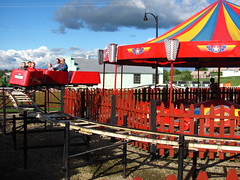 an all-day wristband for around $18.1 It appeared as though most of the people visiting on this Labor Day weekend were out-of-town tourists like ourselves. The whole village was probably here with their families today, but that still couldn’t account for more than a third of the patrons.
an all-day wristband for around $18.1 It appeared as though most of the people visiting on this Labor Day weekend were out-of-town tourists like ourselves. The whole village was probably here with their families today, but that still couldn’t account for more than a third of the patrons.
Little Amerricka is a park I like. It’s sort of like the midwestern version of California’s Adventure City, in that it’s a small park owned and operated by a hobbyist (Lee Merrick, hence the odd park name) that originally opened in the 1990’s as a showcase for a miniature railway set, and then became a haven for vintage fairground and amusement park rides that found their original homes displaced. It gives the impression that the park has a much longer history than it actually does. What’s great about when modeling hobbyists decide to build an amusement park is that there’s never a lack of attention to details. Despite not having huge sums of capital to work with, you can count on all of the rides to be extremely well maintained with a crisp, fresh coat of paint and using all of the original operating equipment. Even the midway, essentially an old parking lot, has been made so festive with banners, streamers, patriotic flags, and filled in with shrubs and potted plants, that you’d barely know the difference. The park will someday install the Hopkins Log Flume that was picked up from auction at Chicago’s Kiddieland, and later will build a recreation of the Lincoln Park Comet hopefully using the original NAD Century Flyer rolling stock. There are no exact timetables for these projects, as the park is a DIY paradise.
decide to build an amusement park is that there’s never a lack of attention to details. Despite not having huge sums of capital to work with, you can count on all of the rides to be extremely well maintained with a crisp, fresh coat of paint and using all of the original operating equipment. Even the midway, essentially an old parking lot, has been made so festive with banners, streamers, patriotic flags, and filled in with shrubs and potted plants, that you’d barely know the difference. The park will someday install the Hopkins Log Flume that was picked up from auction at Chicago’s Kiddieland, and later will build a recreation of the Lincoln Park Comet hopefully using the original NAD Century Flyer rolling stock. There are no exact timetables for these projects, as the park is a DIY paradise.
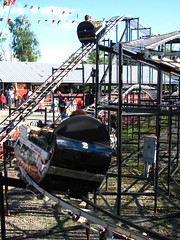 With only an hour and a half before closing time we opted for individual tickets and needed to plan strategically. Our first attraction would be the park’s vintage 1960 Herschell Mad Mouse, located immediately to the right after walking through the depot building which serves as the front entrance. The cars seat one person each, two if you’re with a small child that can fit on your lap, although the line still moves relatively fast thanks to the presence of four cars that rarely stack more than two in the loading platform due to the absence of any restraining device whatsoever in the car save for a seatbelt. Hand over the ticket, hop into the steel tub, give the thumbs up,
With only an hour and a half before closing time we opted for individual tickets and needed to plan strategically. Our first attraction would be the park’s vintage 1960 Herschell Mad Mouse, located immediately to the right after walking through the depot building which serves as the front entrance. The cars seat one person each, two if you’re with a small child that can fit on your lap, although the line still moves relatively fast thanks to the presence of four cars that rarely stack more than two in the loading platform due to the absence of any restraining device whatsoever in the car save for a seatbelt. Hand over the ticket, hop into the steel tub, give the thumbs up,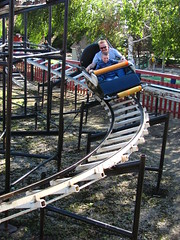 and away you go. The experience can be a bit nerve-wracking because the spindly steel structure looks like it could shake itself apart, and the rails consist of an inverted L-beam barely an inch wide to guide the wheels along. But it’s been working without incident for over fifty years (at least one assumes), so there’s no real need to worry.
and away you go. The experience can be a bit nerve-wracking because the spindly steel structure looks like it could shake itself apart, and the rails consist of an inverted L-beam barely an inch wide to guide the wheels along. But it’s been working without incident for over fifty years (at least one assumes), so there’s no real need to worry.
The small layout is slightly non-standard, due to the lack of enough vertical space to fit many large drops after the standard aerial switchback beginning, it instead fits a couple of helices into the middle superstructure as well as a couple more particularly violent hairpin curves. To cap off the layout, there’s a couple of small dips and hops before the brakes that can provide a brief boost of weightlessness made all the more thrilling for the absence of anything holding you in. The whole thing lasts about a minute, not bad considering it’s basically a giant plug-and-play erector set roller coaster.
Next up was the Wild & Wooly Toboggan, a Chance Toboggan coaster also originally manufactured in the sixties. I’m sure the technology of an enclosed vertical lift hill was fairly impressive for the time, especially as it was mounted to a transportable rig for use in traveling carnivals, but today it is often regarded as one of the worst coaster types ever devised. The first and last time I had been on one was in 2008 at Lakemont Park, and the experience as I described it back then could best be equated to a metaphysical crisis. Ironically, after 500 roller coasters, the scariest rides are no longer ultra-intimidating stratacoasters but things like this.
Get locked inside a claustrophobic cage, tilt all the way on your back, climb up an even more claustrophobic vertical tube with no clear safety features in the event of a power failure, and once you reach the top is when the real terror begins. The layout is basically a downhill spiral that wraps around the lift tube, not really gaining speed due to the continual presence of reduction brakes but not really easing the dizziness either. But the psychological terror is that the whole time I’m thinking about how much longer I have until the violent drop at the end, made nearly impossible to predict due to the restricted visibility out of the car and the fact that my eyes are spinning in circles by the time I get near the bottom anyway. Could be coming any second, but wait, there’s yet another spiral and-
is that the whole time I’m thinking about how much longer I have until the violent drop at the end, made nearly impossible to predict due to the restricted visibility out of the car and the fact that my eyes are spinning in circles by the time I get near the bottom anyway. Could be coming any second, but wait, there’s yet another spiral and-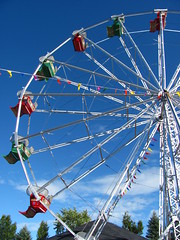
WHOMP.
The vehicle lurches face forward and then immediately yanks me back upright, requiring some defensive cranial maneuvering for taller riders against the low roof. Well, I survived and none the worse for wear so I guess I can’t say it was a regrettable experience (checkmark #567), but even if I was free from time constraints I doubt I’d try a second time as I’d surely be taunting the gods.
While the presence of a Chance Toboggan is a very bad piece of news for any coaster enthusiast who must ride every coaster once for posterity, the good news for enthusiasts is that the Little Dipper has no maximum height or age restrictions to ride, unusual for this model of Allan Herschell kiddy coaster. Since I had never been able to ride one before, now seemed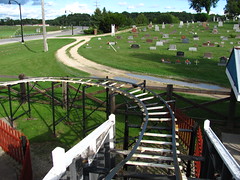 like
like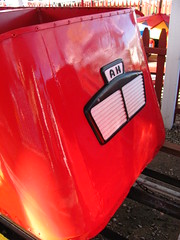 the ideal opportunity. It’s tame and to be honest, consisting only of flat circular curves and a couple minor dips less than five feet deep, deathly boring. The operator was more than happy to welcome me aboard, but that didn’t particularly help ease the embarrassment of riding alone. I don’t know why maximum height restrictions are normally required because anyone over 42 inches tall would have to have a really good reason for wanting to ride it. But it’s also quaint and has cool retro cars. Plus the location is interesting, wrapping around a miniature kiddieland and the view from the top of the lifthill overlooks the neighborhood cemetery.
the ideal opportunity. It’s tame and to be honest, consisting only of flat circular curves and a couple minor dips less than five feet deep, deathly boring. The operator was more than happy to welcome me aboard, but that didn’t particularly help ease the embarrassment of riding alone. I don’t know why maximum height restrictions are normally required because anyone over 42 inches tall would have to have a really good reason for wanting to ride it. But it’s also quaint and has cool retro cars. Plus the location is interesting, wrapping around a miniature kiddieland and the view from the top of the lifthill overlooks the neighborhood cemetery.
 I bought an extra ticket than would be needed to ride each of the coasters once, and decided to use it on the park’s Eyerly Roll-O-Plane they’ve named the Test Pilot. The guy that operated this thing was possibly having more fun than the riders, deliberately faking out endings before sending us around again in reverse, at one point even getting up to pretend to let us out but then deciding, “Nah, you’re not done yet.” The ride lasted at least five minutes, possibly more, which if you’ve ever been on a Roll-O-Plane before you know that would be too much of an otherwise good thing. My mistake, I think, was riding in a capsule opposite two young girls who expressed some reservations about the scariness of the ride to the operator before getting in.
I bought an extra ticket than would be needed to ride each of the coasters once, and decided to use it on the park’s Eyerly Roll-O-Plane they’ve named the Test Pilot. The guy that operated this thing was possibly having more fun than the riders, deliberately faking out endings before sending us around again in reverse, at one point even getting up to pretend to let us out but then deciding, “Nah, you’re not done yet.” The ride lasted at least five minutes, possibly more, which if you’ve ever been on a Roll-O-Plane before you know that would be too much of an otherwise good thing. My mistake, I think, was riding in a capsule opposite two young girls who expressed some reservations about the scariness of the ride to the operator before getting in.
 We just barely made it into the queue for the Meteor on time. They shut it off two people after us, which meant we didn’t have the luxury to choose our seats (we ended up smushed together in the second row of the third car) but at least it was six dollars worth of tickets not wasted. The Meteor is a PTC Junior coaster, relocated from Hillcrest Park which ran the coaster from 1966 to 2003, and which had already been relocated from a different park after it originally opened around 1953. However, its location as the centerpiece of the park gave the impression that the coaster had always been a part of Little Amerricka since opening day. The park apparently bought it partly for practice before attempting to reconstruct a much larger astronomical object, the Comet from Massachusetts’ Lincoln Park.
We just barely made it into the queue for the Meteor on time. They shut it off two people after us, which meant we didn’t have the luxury to choose our seats (we ended up smushed together in the second row of the third car) but at least it was six dollars worth of tickets not wasted. The Meteor is a PTC Junior coaster, relocated from Hillcrest Park which ran the coaster from 1966 to 2003, and which had already been relocated from a different park after it originally opened around 1953. However, its location as the centerpiece of the park gave the impression that the coaster had always been a part of Little Amerricka since opening day. The park apparently bought it partly for practice before attempting to reconstruct a much larger astronomical object, the Comet from Massachusetts’ Lincoln Park.
 There’s not much to the ride save for some gentle drops and a few quick turnarounds, and nothing much in the way of any force, making it possibly the third tamest roller coaster in the park after the Toboggan and Mad Mouse. Nevertheless it’s a great ride to bring people together, and our experience in particular was enriched by another practical joker of a ride operator. After our first ride, and presumed final ride of the evening, we returned to the station only to find that he had time to let us go around for one final victory lap of the night. Woohoo, we cheer, as we’re sent around again. Back in the station, he again lets off the brake lever so we don’t even come to a stop, not even saying a word. Third time’s the charm, right? But okay, after this time, we’re done. Nope. Straight past the brakes and up the lift hill a fourth time, just as a light sprinkle from an ominous storm cloud overhead starts to become noticeable. Alright, we’re surely done now, correct? Five times? Well, at least we’re getting more than our money’s worth, even if we’re starting to get a bit wet. Okay, it’s going to be raining pretty hard any minute now and the entire park has already been emptied out for closing, so we must be on our way…
There’s not much to the ride save for some gentle drops and a few quick turnarounds, and nothing much in the way of any force, making it possibly the third tamest roller coaster in the park after the Toboggan and Mad Mouse. Nevertheless it’s a great ride to bring people together, and our experience in particular was enriched by another practical joker of a ride operator. After our first ride, and presumed final ride of the evening, we returned to the station only to find that he had time to let us go around for one final victory lap of the night. Woohoo, we cheer, as we’re sent around again. Back in the station, he again lets off the brake lever so we don’t even come to a stop, not even saying a word. Third time’s the charm, right? But okay, after this time, we’re done. Nope. Straight past the brakes and up the lift hill a fourth time, just as a light sprinkle from an ominous storm cloud overhead starts to become noticeable. Alright, we’re surely done now, correct? Five times? Well, at least we’re getting more than our money’s worth, even if we’re starting to get a bit wet. Okay, it’s going to be raining pretty hard any minute now and the entire park has already been emptied out for closing, so we must be on our way…
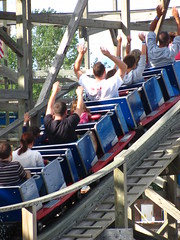 After the sixth involuntary lap we were finally told “I’m done,” (the only two words spoken to us during the entire marathon session) and we had to make a run back to the car as the sky was on the verge of a torrential downpour. Little Amerricka must have some of the coolest (albeit also the most eccentric) employees of any park I’ve been to, to the point that I briefly considered if I wanted to give them my vote for Best Staff in the next Golden Ticket Awards. Although barely larger than a suburban neighborhood block, the park offers a surprisingly large amount to do that I’ll certainly be back to ride the rest of the rides again (whether currently existing or yet to be built) again, especially because we had to skip their signature three mile long Whiskey River Railway. With luck, in another decade or so, I think the small town of Marshall in Wisconsin could have a new Knoebels for the 21st century.
After the sixth involuntary lap we were finally told “I’m done,” (the only two words spoken to us during the entire marathon session) and we had to make a run back to the car as the sky was on the verge of a torrential downpour. Little Amerricka must have some of the coolest (albeit also the most eccentric) employees of any park I’ve been to, to the point that I briefly considered if I wanted to give them my vote for Best Staff in the next Golden Ticket Awards. Although barely larger than a suburban neighborhood block, the park offers a surprisingly large amount to do that I’ll certainly be back to ride the rest of the rides again (whether currently existing or yet to be built) again, especially because we had to skip their signature three mile long Whiskey River Railway. With luck, in another decade or so, I think the small town of Marshall in Wisconsin could have a new Knoebels for the 21st century.
Comments